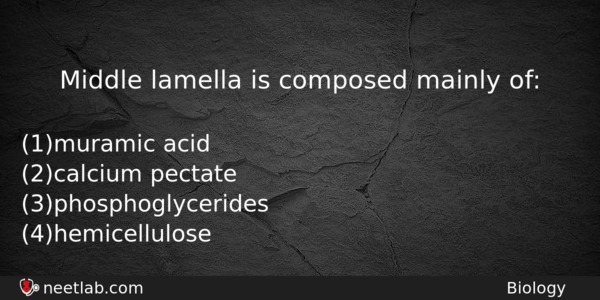| ⇦ | 
| ⇨ |
Middle lamella is composed mainly of:
Options
(a) muramic acid
(b) calcium pectate
(c) phosphoglycerides
(d) hemicellulose
Correct Answer:
calcium pectate
Explanation:
Middle lamella is mainly composed of calcium pectate. Calcium is deposited in plants cell walls during their formation it is required for the stability and function of cell membranes and acts as a type of ‘cementing agent’ in the cell walls in the form of calcium pectate’. Calcium pectate is like a glue binding adjacent cells together so if inadequate calcium is not transported during cell formation, tissues become less stable and prone to disintegration.
Related Questions: - The first stable product of photosynthesis in C plants is
- ABO blood groups in humans are controlled by the gene I
- A free living nitrogen fixing cyanobacterium that can form symbiotic association
- Select the incorrect statement about health from the following:
- An important characteristic that Hemichordates share with Chordates is
Question Type: Memory
(964)
Difficulty Level: Easy
(1008)
Topics: Cell Structure and Functions
(413)
Subject: Biology
(4253)
Important MCQs Based on Medical Entrance Examinations To Improve Your NEET Score
- The first stable product of photosynthesis in C plants is
- ABO blood groups in humans are controlled by the gene I
- A free living nitrogen fixing cyanobacterium that can form symbiotic association
- Select the incorrect statement about health from the following:
- An important characteristic that Hemichordates share with Chordates is
Question Type: Memory (964)
Difficulty Level: Easy (1008)
Topics: Cell Structure and Functions (413)
Subject: Biology (4253)
Important MCQs Based on Medical Entrance Examinations To Improve Your NEET Score
18000+ students are using NEETLab to improve their score. What about you?
Solve Previous Year MCQs, Mock Tests, Topicwise Practice Tests, Identify Weak Topics, Formula Flash cards and much more is available in NEETLab Android App to improve your NEET score.
Share this page with your friends

Leave a Reply